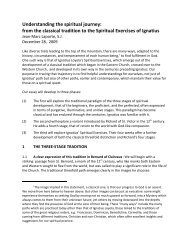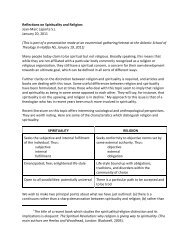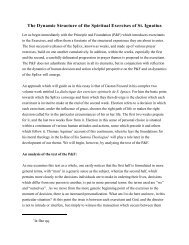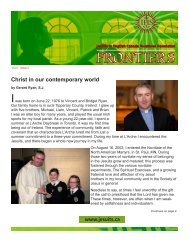A CHRISTIAN TRANSPOSITION OF THE ENNEAGRAM: WITH ...
A CHRISTIAN TRANSPOSITION OF THE ENNEAGRAM: WITH ...
A CHRISTIAN TRANSPOSITION OF THE ENNEAGRAM: WITH ...
You also want an ePaper? Increase the reach of your titles
YUMPU automatically turns print PDFs into web optimized ePapers that Google loves.
to as ego or, in classical enneagram terminology, as personality. The ego is that aspect of my<br />
total self that I readily identify with, and which integrates and shapes my actions and relations.<br />
This ego can be either true/authentic or false/truncated.<br />
4.2.1 The False Ego is defensive, rigid, marked by an imbalance between hyper-consciousness<br />
and repressed consciousness. Faced with a difficult environment, we will exploit a strength<br />
which we perceive within ourselves, and keep on exploiting it as long as we sense that this<br />
strategy works well in getting approval of others and removing threats. That part of ourselves<br />
becomes overdeveloped, and the rest is underdeveloped, and even repressed, and is<br />
unavailable for the ongoing integration of our total self.<br />
To have a false ego is to be touched by the dynamic of sin. The opposite of sin in this sense is to<br />
refrain from clutching defensively to the strength with which we are endowed, but to hold it in<br />
an open-handed manner. Sin means changing my basic attitude towards the gifts that God<br />
bestows upon me from “I am beloved of God and what God bestows on me is for others as well<br />
as for myself” to “I have these gifts and they are mine to defend myself and enhance my<br />
16<br />
status”.<br />
4.2.2 The Authentic Ego is the ego which functions in accord with the model of flexible and<br />
fluid consciousness. Not everything about us is integrated into the true ego, but it builds no<br />
rigid barriers, no obstacles to further development. This ego is a true instrument and<br />
exteriorization of the self, one which seeks to include and integrate all the psychic potential of<br />
the person, all his/her gifts. It is a good servant of the self, helping it establish genuine<br />
17<br />
relationships, and originate actions which are constructive and compassionate.<br />
4.3 <strong>THE</strong> DYNAMIC <strong>OF</strong> <strong>THE</strong> FALSE EGO:<br />
The basis for our false ego is laid during our earliest years, when we are the most vulnerable<br />
16<br />
The enneagram teaching develops nine possible patterns of false ego one of which<br />
predominates in each human being, basically because of patterns that were set in very early childhood,<br />
in relation to our environment and those who care for us. What is the respective role of the particular<br />
environment which envelops us, which includes the personalities and actions of our mothers, fathers,<br />
siblings, and our own bodily-based temperament, with its strengths/weaknesses This is a chicken and<br />
egg question. It makes sense to entertain the view that one’s original bodily and neurological<br />
endowment has an impact on what strategies gradually firm up in infants and young children as they<br />
face the issues arising in their environment. More research is needed for conclusive answers.<br />
17<br />
Some enneagram authors speak about dismantling the ego – which for them is a false ego –<br />
without referring to the true ego which replaces it. This gives access to the essence, or self, but that<br />
essence or self cannot function in the world without an ego to serve as its instrument. The issue is not<br />
that of whether we function with or without an ego, but of our self being hindered by a false ego rather<br />
than helped by an authentic ego.<br />
12










